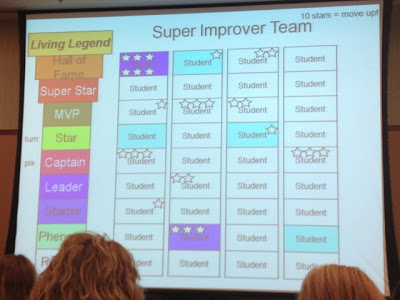In my ideal world, my gradebook would be broken down into 2 categories: proficiency and growth. Or maybe they could just be one in the same, inextricably linked.
Carol Dweck’s book Mindset has changed the way I talk to my students and give them feedback. I now talk to them to incite small changes; to be aware of where they are now without judgement and challenge themselves to improve. I teach them this because this is how I live. I am not perfect and sometimes I can become dismayed at my lack of perfection. Growth mindset helps me and helps my students. 
Growth Mindset for Grading
I had the pleasure of visiting Bryce Hedstrom‘s class a few weeks ago. Bryce and I had also attended the CCFLT fall conference on Whole Brain Teaching. Chris Biffle, the founder of Whole Brain Teaching, has a growth mindset system for challenging every single student. His system is called Super Improvers. I saw Bryce put this improvement method into practice during his speaking assessment. He told students that if they got a C on the rubric, they would get an A on the assessment, but if they wanted to keep the A, they would have to improve a little on the next speaking assessment. He has created a Language Performance Scale for Telling a Story and it is available for free here!
I instantly put this system into practice in my class. It allows me to meet students at their level and challenge them to continually improve. No one feels like a failure and no one gets to rest on their laurels.
I have also used Bryce’s Participation Grading Scale and added an element of growth mindset to it. Here is the participation rubric. This will give me documentation to check in with them later to assess if they have met that goal.
So far, I can assess student growth on:
- Speaking
- Participation
- Writing – using words per minute and the Free Write Targets Rubric
My end goal is to choose a class to display this Super Improvers’ Wall, as taught by Chris Biffle. Students would challenge their personal best and each time they improve, either academically or behaviorally, they will get a star. After 10 stars, they level up to the next color and label. 
(We’ll see if this is something I can actually pull off!)
Growth Mindset has changed the culture in class because students no longer work to gain rewards or avoid punishment. They work because they value improvement and feel success when they do improve.

Thank you for all your resources and ideas. They are much appreciated. I am wondering how often you use the participation rubric you have posted here. Do you use it each week or just after stories or a few times per quarter? Do you fill one out too or is their self-eval what they get? I appreciate your time!
LikeLike
Hi Travis! In my ideal world, I would do them after every storyasking session (so about once every 6th day.) I usually end up doing about one a month. I pair it with a listening quiz. If they are doing all 10 things, they should score high on the quiz. If they do poorly on the quiz, we can use their self-assessment as a way to drive the conversation and help them be more successful.
LikeLike
I guess I am also curious how your overall grades are broken down. How much is the participation/engagement grade worth, do you have other grade categories, etc.? Thank you!
LikeLike
I only have 2 categories: 30% Practice and 70% Assessments. Assessments are reading, writing, listening and speaking quizzes or proficiency checks. The 30% includes practice and participation.
LikeLike